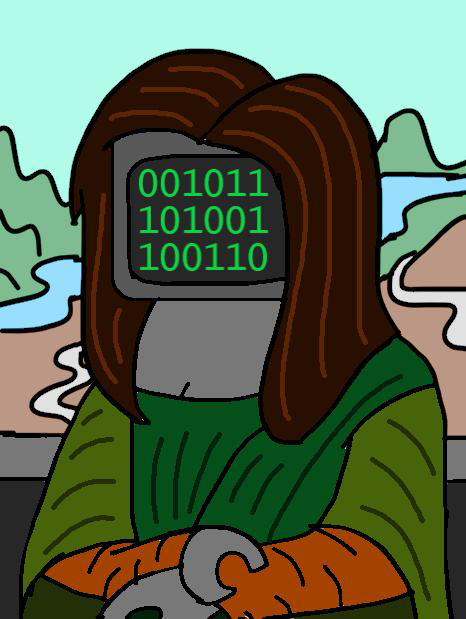AI Art is Unethical and Discredits Artists
February 3, 2023
Art and technology are two fields that are constantly expanding in our modern society. New art forms are imagined and technological advances are made daily. The two fields have a long history of influencing each other, but there is a point where this collaboration goes too far. Art generated by Artificial Intelligence (AI) is a relatively new, but fast-growing trend, generating controversy just as quickly, and igniting multiple questions about plagiarism and ethics. Because of this and more, people shouldn’t participate in or condone the plagiarism of original art and techniques perpetrated by AI art systems.
Artificial intelligence cannot function on its own, as it needs to mimic the human thought process and intelligence. It cannot feel emotions or be creative, so for it to make “art,” it needs to get reference from actual art made by humans. This means that human artists, who put countless hours of effort and creativity into their work, are having their artworks appropriated by AI without their knowledge or consent.
According to The Guardian, Kim Leutwyler, an Australian-based artist, said that the popular app known as Lensa was noticeably replicating distinctive art styles. Leutwyler said, “Some of the work is distinctly recognisable to other artists’ work. They are calling it a new original work but some artists are having their exact style replicated exactly in brush strokes, techniques that take years and years to refine.” She added, “It’s frustrating and it feels like a violation. We’ve not been compensated, we’ve not been credited” (theguardian.com). It is natural for humans to be inspired by others’ art. However, humans only use the inspiration to further develop their own style. What AI-generated art is doing with replicating peoples’ styles and not crediting them is, by definition, plagiarism.
AI art apps like Lensa are also problematic when it comes to ethics. According to a design ideas website, some users who have had portraits generated for them have noticed that the AI sexualized them significantly. “Lensa’s Magic Avatar has also generated nude art based on photographs of children, lightened black skin, and made users significantly thinner than they appear in the source images they uploaded. AI training data like LAION is full of racist stereotypes, pornography, and even explicit images of rape. Of course, AI training data reflects the biases and prejudices of human artists and other content producers, but there doesn’t appear to be any attempt on the app creators’ part to moderate that data” (dornob.com). Artificial intelligence having ethical issues is nothing new. If AI art is going to have the same, if not, worse, ramifications as human-made pieces, why even have it in the first place?
While talking about his stop-motion adaptation of Pinocchio, Director Guillermo del Toro also expressed distaste in AI-generated art. He said, “I think that art is an expression of the soul. At its best, it is encompassing everything you are. Therefore, I consume, and love, art made by humans. I am completely moved by that. I am not interested in an illustration made by machines and the extrapolation of information” (nextshark.com). AI of all forms risks putting unthinkable numbers of workers out of a job and replaced with robots. Art, which is arguably one of the most important features of humanity, cannot be put at risk.
Freshman Alena Boehmer has mixed feelings about AI-generated art. Boehmer said, “While it is fun to see what AI can do with a simple prompt, having art being stolen to teach the AI isn’t so fun. I’ve even seen stories where people use AI-generated art to win contests and such.” She continued, “It’s also so demotivating to see AI art get so much praise when it takes no effort, while some people take hours and even days to make art. [AI art] seemed interesting when it started, but it’s just stolen [art].”
Using artificial intelligence to make images is an easy shortcut for those who do not possess artistic skills. But these abilities are not only available to a select few. These skills can, and are, learned with time and patience. People should express their own artistic talents instead of relying on uncreative and emotionless AI to do it for them, a method that is only viable by unethically plagiarizing genuine art.





John Edwards • Mar 2, 2023 at 9:33 pm
Its criminal thst this doesn’t have more comments. I agree with this. Ai art is definitely a new milestone for tech, but the way its being used and created is just wrong.
Heres a good use case, you want to see art work in a dead artists style or how they would draw something, with stuff like open ai you can bring back these artist and even interact with them to an extent, learn from them even. Imagine chatting with an ai version of davinci over something like Memes and how davinci would have created a meme, something that would inspire a person to pick up a pencil and draw.
Or imagine if an artist fed their work to a custom ai specifically trained in their work so that people can use this ai for cheap art while both recognizing and compensating that specific artist. It can also be a living biography.
Or imagine writers who write a series and sadly passes away before the conclusion, an ai could create several likely endings based on that artist’s existing work free from outside influence.
Ai can work and be ethical, more importantly, it can exist right beside artist if people cared enough to be considerate.